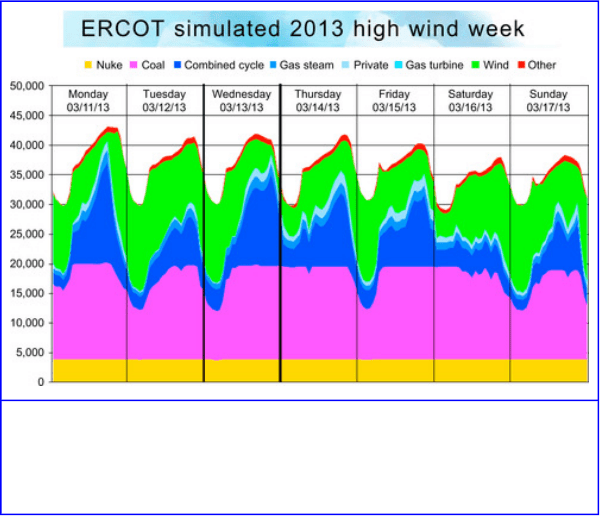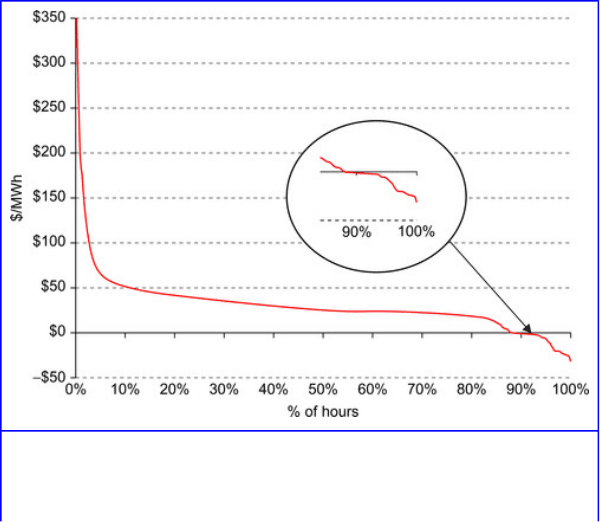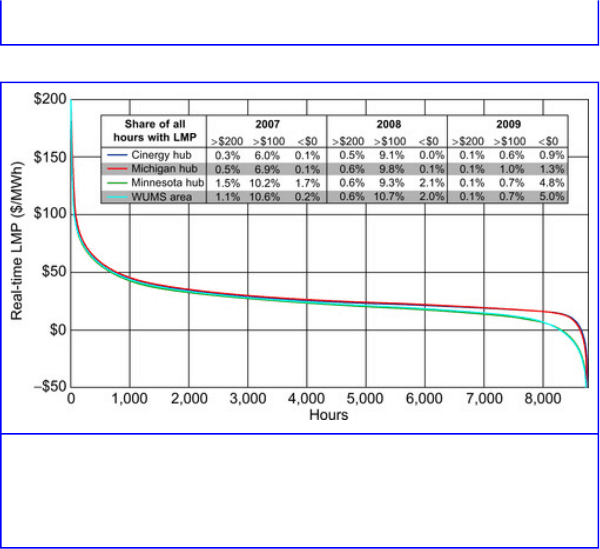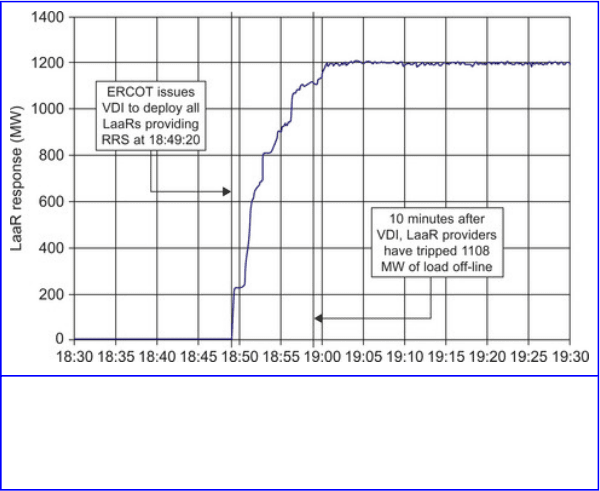Sioshansi F.P. Smart Grid: Integrating Renewable, Distributed & Efficient Energy
Подождите немного. Документ загружается.


http://www.puc.state.tx.us/about/commissioners/smitherman/present/pp/
GDF_Suez_111209.pdf.
Figure 10.5
Increased cycling of conventional generation.
Source: ERCOT Energy Seminar 2009, Public Utility Commission of Texas, November 12, 2009
Third, system operators are increasingly concerned with an
empirical system operation challenge known as
“over-generation.” In many geographical regions, wind is
most likely to be strongest during off-peak periods such as
late night and early in the day. This creates a problem—the
higher wind generation output tends to come at a time when
demand is at its lowest. Since the system must accommodate
the renewable generation as must-take, this requires that
conventional resources reduce their output to “make room”
for the higher wind output. While some conventional
generation can be easily dispatched down, the situation is
511
exacerbated when the only generation left to reduce is
baseload generation. Most baseload plants have relatively
high minimum generation level requirements
26
and long
start-up and shut-down times—they cannot be turned off
economically and reliably overnight if they will have to be
turned back on again the next day. This creates tension
because neither baseload generation nor wind generation
owners have an economic interest in seeing their generation
curtailed during periods of over-generation.
26
For example, the largest coal plants are estimated to have a minimum
generation level of 40–50% relative to their peak generation capacity.
See Shankar [6].
In fact, those generator owners would be willing to receive
zero or slightly negative prices for their output before they
would agree to reduce their production levels.
27
This
situation is particularly challenging because wind generators
are often likely to see higher outputs at night, which places
greater pressure on conventional base generation to step in
and provide higher levels of output during the day after it has
already been asked to dial down at night—as a result, both
energy margins and operation and maintenance costs are
altered. Negative energy prices have already been observed in
Texas and the Midwest. As Figure 10.6 demonstrates,
approximately 10% of hours had negative real-time prices in
ERCOT's West Zone.
28
Figure 10.7 illustrates similar
conditions experienced by MISO,
29
where as many as 5% of
the hours were characterized by negative real-time energy
prices in 2009.
27
In many cases, wind plants that qualify for Renewable Energy Credits
(RECs) and/or Production Tax Credits (PTC) are willing to receive
512

negative market energy prices because their opportunity cost of not
producing would be the foregone values of RECs and PTCs, which in
most cases are greater than $20/MWh. In some cases, the generator is
paid both for the implied value of RECs and PTCs through their
long-term contracts with load-serving utilities even if the power is
curtailed. This results in generators willing to curtail even before
receiving negative prices. However, under those circumstances, rate
payers who ultimately pay for the renewable generation contracts may be
left paying twice, once for the environmental attributes that they never
received due to the curtailment, and also for the coal generation that
could not be backed off.
28
Source: ERCOT market data from http://www.ercot.com.
29
Source: 2009 State of the Market Report Midwest ISO.
Figure 10.6
Real-time price duration curve ERCOT West Zone 2010.
513

Source: ERCOT market data from http://www.ercot.com
Figure 10.7
Real-time price duration curve Midwest ISO: pricing hubs all hours 2009.
Source: 2009 State of the Market Report Midwest ISO
Finally, given that increasing levels of renewable portfolio
standards must be met via a substantial penetration of wind
generation, which has near-zero marginal costs, wind
generators are typically operated as must-run generation.
Operated as must-run, they force the grid operator to reduce
the output of existing marginal generation resources,
triggering all of the adverse impacts discussed earlier. In
deregulated markets, however, generators may have no
revenues sources beyond hourly energy sales and capacity
market payments. Therefore, the consequent revenue
reductions could result in some plants exiting the market,
reducing the availability of conventional cycling and peaking
514
generation at a time when it might be increasingly needed to
provide flexible generation services.
Increased operation and maintenance costs and higher heat
rates are not the only negative effects of increased cycling of
conventional generation. Higher heat rates due to inefficient
and more frequent cycling instructions also result in increased
emissions—higher emissions are directly translated into
adverse environmental impacts and higher air emission
compliance costs. In order to provide flexibility services for
greater levels of renewable generation penetration,
conventional units will have to operate at lower output levels
to preserve their ability to respond to increased net
load-following and regulation ramps. Those units are most
likely to be combined cycle gas turbines.
In general, combined cycle gas turbines (CCGT) have low
NOx burners, which reduce their nitrous oxides emissions by
lowering the temperature of combustion. Unfortunately, this
type of emission control has considerably reduced
effectiveness if the generator operates at less than 60% of its
nominal rating—this is likely to occur when it is operating as
a regulation or load-following service resource for a system
with large levels of renewable generation installed. This
scenario is also likely in the instance when “must-take”
renewable generation forces reductions in CCGTs, generation
output level or heat rate efficiency. Furthermore, baseload
units that have been forced to cycle but are not designed to do
so will also, as outlined above, suffer from increased heat
rates—as a result, those generators will be burning
significantly greater amounts of fossil fuels to generate the
same level of electricity. Again, the increased fuel usage will
lead to higher fossil-fuel emissions.
515
Load as a Flexible Resource – System Programs
and Experience
Given all of the issues discussed above with regard to the use
of generation resources as a means of integrating intermittent
resources, demand response is rapidly becoming a potential
alternative for the provision of flexibility services to the grid.
Given a proper telemetric and communication infrastructure,
load entities can be just as effective in providing flexibility
services, such as regulation and load-following, while
demonstrating desirable response times and ramping
capabilities. The benefits of relying on demand response to
provide regulation and load-following are multiple. On the
one hand, as we have already discussed, there is growing
empirical evidence that a higher penetration of renewable
resources will result in faster ramping rate requirements for
units providing regulation and load-following. Conventional
generation with such specifications comes at a higher cost; in
addition, alternative technologies such as battery storage are
still quite expensive and limited in their sustained response
time. Load, on the other hand, can effectively provide a
high-quality service exhibiting both instantaneous response
and fast ramp rates. Furthermore, relying on demand response
will avoid the issues of increased cycling, higher emissions,
and higher O&M costs that arise with conventional
generation.
ISOs and utilities have begun to realize the benefits of relying
on demand response for regulation and load-following. The
success of enabling demand response customers to bid into
capacity markets has led systems to open up their energy and
ancillary service markets to entities providing load control.
For example, the New York Independent System Operator
516
(NYISO) has four demand response programs: the
Emergency Demand Response Program (EDRP), the ICAP
Special Case Resources (SCR) program, the Day Ahead
Demand Response Program (DADRP), and the Demand Side
Ancillary Services Program (DSASP).
30
The EDRP and SCR
programs are capacity programs in which load resources are
curtailed in energy shortage events in order to maintain a
reliable system. The DADRP program allows load resources
to bid into NYISO's day-ahead energy market in a method
similar to generators. Finally, the DSASP program allows
load resources to provide load-following and regulation
services.
30
Source: NYISO [7].
Capacity programs are still NYISO's most popular product for
demand response, followed by energy markets, and then
ancillary services. By August 2010, approximately 2,495 MW
of demand response enrolled in NYISO's EDRP and SCR
programs while only 331 MW of demand response enrolled in
NYISO's DADRP and no entity has qualified for the DSASP.
31
While no load entities have yet to qualify to participate in
NYISO's DSASP market, several customers have expressed
interest and are currently going through the registration and
qualification process.
31
Ibid.
The story is similar for demand response programs in the PJM
system. Like NYISO, PJM allows load entities to participate
in their capacity, energy, and ancillary service markets. And
like NYISO, demand response participation is almost an order
of magnitude greater in PJM's capacity market (8,683 MW)
517
versus its energy market (1,727 MW).
32
But unlike NYISO,
load is an active participant in PJM's ancillary service
markets, particularly PJM's synchronized reserve market that
provides load-following services. In the first quarter of 2011,
demand response provided on average 84,551 MWh of
synchronized reserve service in PJM, which translates to an
average demand response capacity of 118 MW.
32
Source: Monitoring Analytics [8].
The Midwest Independent System Operator (MISO) demand
response participation is also similar to NYISO and PJM. It
allows demand response resources to participate in its
capacity, energy, and ancillary service markets. But where
MISO differs is that it has 17 MW of load from an aluminum
smelter providing regulation service, making it the only ISO
or RTO to have a load entity providing flexible operating
reserve service on timescales shorter than 10 minutes.
As described below, events in ERCOT have shown the
importance of load resources in integrating wind and solar
power. ERCOT has approximately 2,200 MW of demand
response participating in their Load acting as Resource
(LaaR) program, and the load resources regularly provide up
to half of ERCOT's responsive reserve requirement.
33 and 34
In addition, ERCOT also has experienced a significant
build-out of wind power with a cumulative nameplate
capacity of over 10 GWs of wind power installed by the end
of 2010 providing 6.4% of the electricity in Texas.
35
The
differences in wind generation's operation from conventional
fossil-fuel or hydro generators have led ERCOT's system
operators to adapt their methods to successfully integrate the
increasingly larger amounts of wind energy fed into their
518
system. The updated methods have not been perfect, and there
have been events that threatened the stability of the system.
One such event occurred in ERCOT on February 26, 2008,
and ERCOT's LaaR resources played a pivotal role in
maintaining the stability of ERCOT's electrical grid.
33
ERCOT's LaaR program is a program where load resources with
interruptible capabilities provide balancing energy service
(load-following ancillary service).
34
Source: Newell and Hajos [9].
35
Source: American Wind Energy Association [10].
On February 25, 2008, ERCOT had forecasted its hourly
MWs of load and wind power expected on its system and had
arranged for adequate generation plus a reserve of 1,400 MW.
ERCOT learned on February 26 that its load forecast did not
adequately capture a large and rapid increase in demand of
2,550 MW that occurred between 6:00 PM and 6:41 PM.
Unfortunately, this rapid increase in demand coincided with a
drop-off in wind power production that had begun earlier,
happened faster, and was larger by 1,000 MW than their wind
forecast predicted.
36
36
Source: ERCOT [11].
These two events combined to deplete ERCOT's operating
reserves over the course of 40 minutes from 6:00 PM to 6:40
PM. At 6:41 PM, ERCOT implemented step 2 of its
Emergency Electric Curtailment Plan (EECP) and called upon
1,150 MW of LaaRs to reduce the load. Within 10 minutes of
receiving instructions to curtail, 1,108 MW of LaaRs had
519

curtailed their demand (Figure 10.8). According to ERCOT,
the deployment of LaaRs halted the decline in system
frequency and “restored ERCOT to stable operation.”
Figure 10.8
ERCOT LaaR responsive reserve deployment during February 26, 2008, event.
Source: ERCOT [11]
Although utilities and RTOs have successfully enrolled large
quantities of demand response in capacity, energy, and
ancillary service markets, these demand response products
have been designed to help a system in one direction, namely
by reducing load. This has been adequate in the past because
historically the common emergency events that a system
encountered have been shortages in generation. Yet the
significant build-out of wind power combined with RPS
obligations and the constraints of operating limits of
conventional generators to increase the likelihood of
over-generation events where a system produces more energy
520
